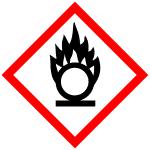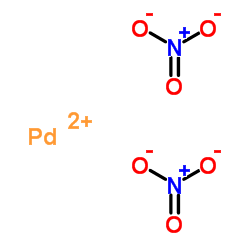10102-05-3
| 中文名 | 硝酸钯 |
|---|---|
| 英文名 | Palladium nitrate |
| 英文别名 |
PaladiumNitrate
PALLADIUM STANDARD SOLUTION PALLADIUM(II) NITRATE 2 H2O Palladous nitrate Palladium(II) nitrate Palladium(II) nitrate dihydrate Palladium(II) nitrate solution MFCD00011169 palladium dinitrate palladiumdinitrate Palladium nitrate di UNII-5G27LBZ05U EINECS 233-265-8 Pa Nitrate nitric acid, palladium(2+) salt Palladium(2+) dinitrate PALLACIUM(II)NITRATE |
| 密度 | 1.118 g/mL at 25 °C |
|---|---|
| 沸点 | 83ºC at 760 mmHg |
| 熔点 | >100ºC |
| 分子式 | N2O6Pd |
| 分子量 | 230.430 |
| 精确质量 | 229.879120 |
| PSA | 137.76000 |
| LogP | 0.56820 |
| 外观性状 | 黄色或橙色棕色液体,酸味 |
| 储存条件 | 储存注意事项 储存于阴凉、通风的库房。远离火种、热源。库温不超过30℃,相对湿度不超过80%。包装密封。应与易(可)燃物、还原剂等分开存放,切忌混储。储区应备有合适的材料收容泄漏物。 |
| 稳定性 | 1.稳定性 稳定 2.禁配物 还原剂、易燃或可燃物、活性金属粉末、硫、磷 3.避免接触的条件 受热 4.聚合危害 不聚合 5.分解产物 氮氧化物 |
| 分子结构 | 1、摩尔折射率:无可用的 2、摩尔体积(cm3/mol):无可用的 3、等张比容(90.2K):无可用的 4、表面张力(dyne/cm):无可用的 5、介电常数:无可用的 6、极化率(10-24cm3):无可用的 7、单一同位素质量:229.879119 Da 8、标称质量:230 Da 9、平均质量:230.4298 Da |
| 计算化学 | 1.疏水参数计算参考值(XlogP):无 2.氢键供体数量:0 3.氢键受体数量:6 4.可旋转化学键数量:0 5.互变异构体数量:无 6.拓扑分子极性表面积126 7.重原子数量:9 8.表面电荷:0 9.复杂度:18.8 10.同位素原子数量:0 11.确定原子立构中心数量:0 12.不确定原子立构中心数量:0 13.确定化学键立构中心数量:0 14.不确定化学键立构中心数量:0 15.共价键单元数量:3 |
| 更多 | 1.性状:棕黄色结晶或粉末,有潮解性。 2.熔点(℃):分解 3.相对密度(水=1):1.118 4.溶解性:溶于水,溶于稀硝酸。 |
|
Section 1: Product Identification Chemical Name:Palladium (II) nitrate hydrate(Pd approx. 40%) (99.9%-Pd) CAS Registry Number:10102-05-3 Formula:Pd(NO3)2.XH2O EINECS Number:233-265-8 Chemical Family:metal nitrate salts Synonym:Palladium dinitrate, Nitric acid, palladium (+2) salt
Section 2: Composition and Information on Ingredients IngredientCAS NumberPercentACGIH (TWA)OSHA (PEL) Title Compound10102-05-3100%no datano data Section 3: Hazards Identification Emergency Overview:Irritating to eyes, skin and respiratory tract. May be harmful if swallowed. Primary Routes of Exposure:Ingestion Eye Contact:Causes slight to mild irritation of the eyes Skin Contact:Causes slight to mild irritation of the skin. Inhalation:Irritating to the nose, mucous membranes and respiratory tract. Ingestion:Ingestion may lead to dizziness, abdominal cramps, vomiting, bloody diarrhea, weakness, and convulsions. Acute Health Affects:Irritating to skin, eyes and respiratory tract. Chronic Health Affects:No information available on long-term chronic effects. NTP:No IARC:No OSHA:No SECTION 4: First Aid Measures Immediately flush the eyes with copious amounts of water for at least 10-15 minutes. A victim may need Eye Exposure: assistance in keeping their eye lids open. Get immediate medical attention. Wash the affected area with water. Remove contaminated clothes if necessary. Seek medical assistance if Skin Exposure: irritation persists. Remove the victim to fresh air. Closely monitor the victim for signs of respiratory problems, such as difficulty Inhalation: in breathing, coughing, wheezing, or pain. In such cases seek immediate medical assistance. Seek medical attention immediately. Keep the victim calm. Give the victim water (only if conscious). Induce Ingestion: vomiting only if directed by medical personnel. SECTION 5: Fire Fighting Measures Flash Point:not applicable Autoignition Temperature:none Explosion Limits:none Extinguishing Medium:carbon dioxide, foam or dry powder If this product is involved in a fire, fire fighters should be equipped with a NIOSH approved positive pressure Special Fire Fighting Procedures: self-contained breathing apparatus and full protective clothing. Hazardous Combustion andIf involved in a fire this material may emit irritating fumes. Decomposion Products: Unusual Fire or Explosion Hazards: Metal nitrates can be oxidizers. Contact with strong reducing agents could lead to fires and/or explosions. SECTION 6: Accidental Release Measures Spill and Leak Procedures:Small spills can be mixed with vermiculite or sodium carbonate and swept up. SECTION 7: Handling and Storage Handling and Storage:Store in a tightly sealed container. Keep away from heat and direct sunlight. SECTION 8: Exposure Controls and Personal Protection Eye Protection:Always wear approved safety glasses when handling a chemical substance in the laboratory. Skin Protection:Wear protective clothing and gloves Ventilation:If possible, handle the material in an efficient fume hood. If ventilation is not available a respirator should be worn. The use of respirators requires a Respiratory Respirator: Protection Program to be in compliance with 29 CFR 1910.134. Ventilation:If possible, handle the material in an efficient fume hood. Additional Protection:No additional protection required. SECTION 9: Physical and Chemical Properties Color and Form:brown xtl. Molecular Weight:230.72 Melting Point:dec. Boiling Point:no data Vapor Pressure:not applicable Specific Gravity:no data Odor:none Solubility in Water:very soluble SECTION 10: Stability and Reactivity Stability:air and moisture stable Hazardous Polymerization:no hazardous polymerization Contact with strong reducing agents or organic matter. Some nitrates can explode if heated to high Conditions to Avoid: temperatures. Incompatibility:reducing agents, organic matter, phosphorus and sulfur Decomposition Products:nitrogen oxides and palladium salts SECTION 11: Toxicological Information RTECS Data:Intraperitoneal (rat); DNA inhibition: 56 umol/kg. Carcinogenic Effects:No data available Mutagenic Effects:Possible mutagenic effects reported in RTECS Tetratogenic Effects:No data available SECTION 12: Ecological Information Ecological Information:No data available SECTION 13: Disposal Considerations Disposal:Dispose of according to local, state and federal regulations. SECTION 14: Transportation Shipping Name (CFR):Nitrates, Inorganic, N.O.S. Hazard Class (CFR):5.1 Additional Hazard Class (CFR):NA Packaging Group (CFR):II UN ID Number (CFR):UN# 1477 Shipping Name (IATA):Nitrates, Inorganic, N.O.S. Hazard Class (IATA):5.1 Additional Hazard Class (IATA):NA Packaging Group (IATA):II UN ID Number (IATA):UN# 1477 SECTION 15: Regulatory Information TSCA:Listed in the TSCA inventory. SARA (Title 313):Title Compound: See Category Code N511 for reporting. Second Ingredient:none SECTION 16 - ADDITIONAL INFORMATION N/A |
|
毒理学数据: 1.急性毒性 暂无资料 2.刺激性 暂无资料 生态学数据: 1.生态毒性 暂无资料 2.生物降解性 暂无资料 3.非生物降解性 暂无资料 4.其他有害作用 该物质对环境有危害,应特别注意对水体的污染。 CHEMICAL IDENTIFICATION
HEALTH HAZARD DATAACUTE TOXICITY DATAMUTATION DATA
|
| 符号 |


GHS03, GHS05 |
|---|---|
| 信号词 | Danger |
| 危害声明 | H272-H314 |
| 警示性声明 | P210-P280-P303 + P361 + P353-P304 + P340 + P310-P305 + P351 + P338 |
| 个人防护装备 | Eyeshields;Faceshields;full-face particle respirator type N100 (US);Gloves;respirator cartridge type N100 (US);type P1 (EN143) respirator filter;type P3 (EN 143) respirator cartridges |
| 危害码 (欧洲) | Xi: Irritant;C: Corrosive;O: Oxidizing agent; |
| 风险声明 (欧洲) | R34 |
| 安全声明 (欧洲) | S26-S36/37/39-S45-S17 |
| 危险品运输编码 | UN 3264 8/PG 2 |
| WGK德国 | 3 |
| RTECS号 | QV0560000 |
| 包装等级 | II |
| 危险类别 | 5.1 |


